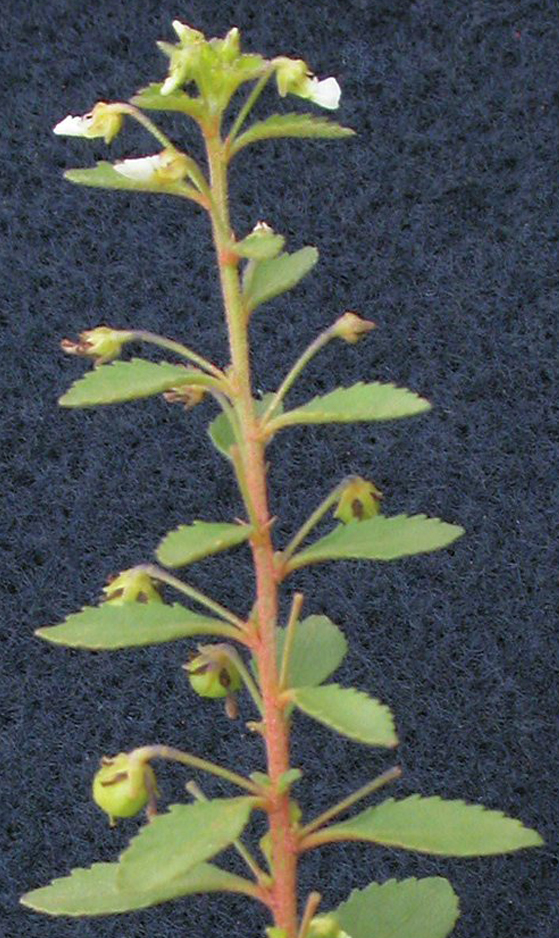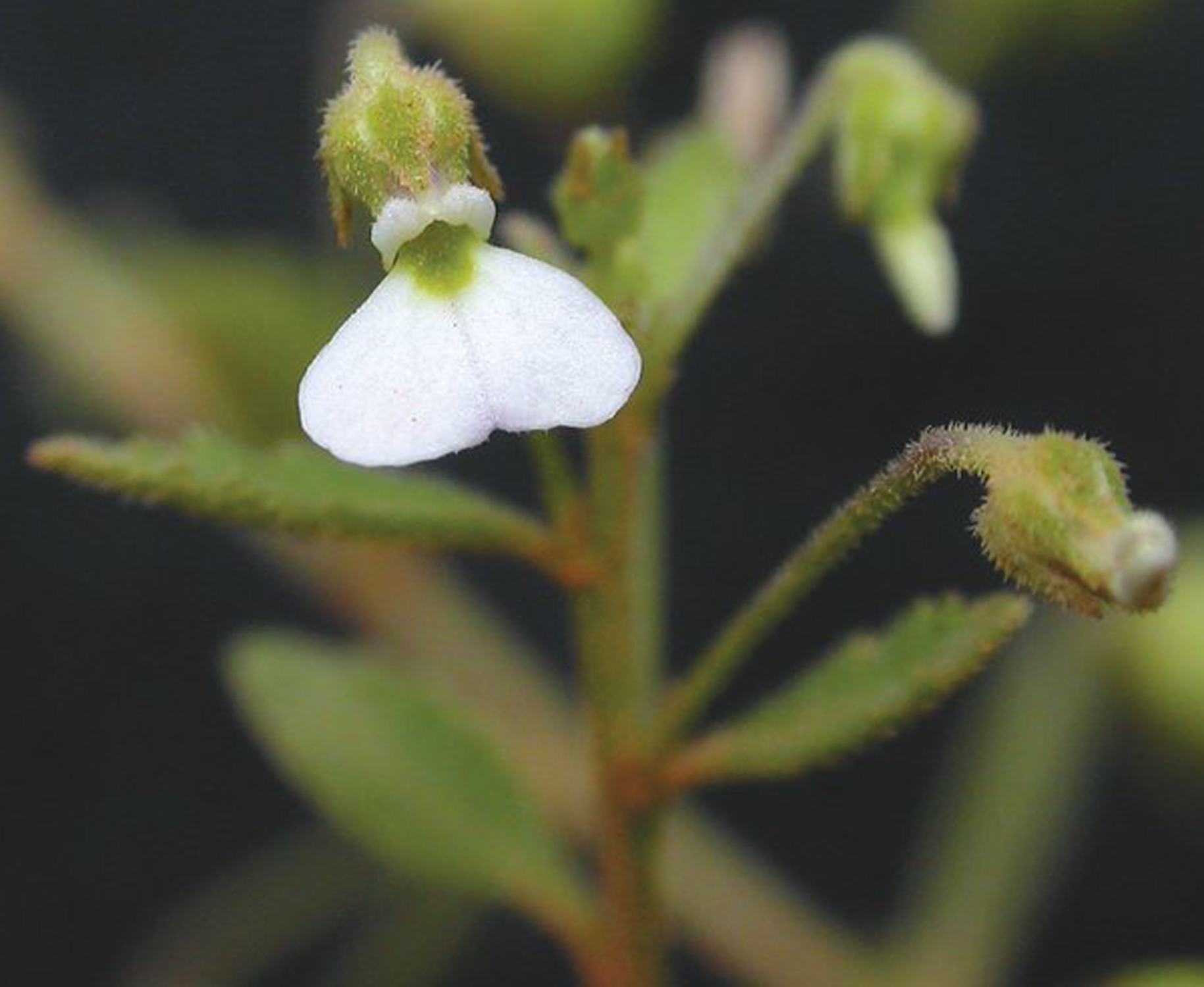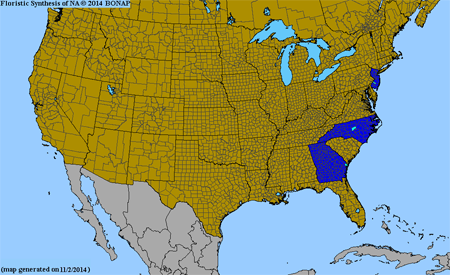Pombalia parviflora (Mutis ex L.f.) Paula-Souza
Common names:
Violetilla
Synonyms:
Pombalia parviflora (Mutis ex L.f.) Paula-Souza, in Paula-Souza and H.E.Ballard, Phytotaxa 183(1): 10. 2014; Calceolaria parviflora (Mutis ex L.f.) Kuntze, Revis. gen. pl. 3(2): 8. 1898; Ionidium glutinosum Vent. var. parviflorum (Mutis ex L.f.) Eichler, Fl. bras. 13(1): 374. 1871;Solea parviflora (Mutis ex L.f.) Spreng., Syst. veg. 1: 804. 1825 ["1824"]; Ionidium parviflorum (Mutis ex L.f.) Vent., in Vent. & Redouté, Jard. Malmaison 1(5): pl. 27. 1803; Viola parviflora Mutis ex L.f., Suppl. pl.: 360. 1782 ["1781"]. Type: "Habitat in Americae meridionalis calidioribus regionibus" [protologue], [no date], Mutis s.n. (holotype: LINN1052-25).
Viola venezuelensis Steyerm., Fieldiana, Bot. 28: 403, fig. 85A-J. 1952
Hybanthus parviflorus (Mutis ex L.f.) Baill. var. bangii (Rusby) Sparre, Lilloa 23: 535. 1950; Calceolaria bangii Rusby, Mem. Torrey Bot. Club 3(3): 6. 1893
Hybanthus parviflorus (Mutis ex L.f.) Baill. var. chamaedrifolius (C.Presl) Sparre, Lilloa 23: 535. 1950; Ionidium chamaedrifolium C.Presl, Reliq. haenk. 2(2): 96. 1831-1835
Hybanthus parviflorus (Mutis ex L.f.) Baill. var. argentinensis Sparre, Lilloa 23: 535, fig. 1a, pl. 1. 1950
Hybanthus parviflorus (Mutis ex L.f.) Baill. f. microphyllus (Kunth) Schulze-Menz, Bot. Jahrb. Syst. 67: 485. 1936; Hybanthus microphyllus (Kunth) Baill., Traité bot. méd. phan. 2(3): 841. 1884 ["1883-1884"]; Ionidium microphyllum Kunth, in Humb., Bonpl. & Kunth, Nov. gen. sp. 5(23)[quarto]: 374, pl. 495. 1823
Hybanthus parviflorus (Mutis ex L.f.) Baill. f. membranaceus Schulze-Menz, Bot. Jahrb. Syst. 67: 485. 1936
Hybanthus parviflorus (Mutis ex L.f.) Baill. var. glutinosus (Vent.) Hassl., Bull. Soc. Bot. Genève, Sér. II, 1: 214. 1909; Hybanthus glutinosus (Vent.) Taub., in Engl. & Prantl, Nat. Pflanzenfam., ed. 1, 3(6): 333. 1895; Calceolaria glutinosa (Vent.) Kuntze, Revis. gen. pl. 1: 41. 1891; Solea glutinosa (Vent.) Spreng., Syst. veg. 1: 804. 1825 ["1824"]; Viola glutinosa (Vent.) Poir., Encyc. 8: 647. 1808; Ionidium glutinosum Vent., in Vent. & Redouté, Jard. Malmaison 1(5): pl. 27. 1803
Hybanthus parviflorus (Mutis ex L.f.) Baill. var. angustifolius (Eichler) Hassl., Bull. Soc. Bot. Genève, Sér. II, 1: 214. 1909; Calceolaria parviflora (Mutis ex L.f.) Kuntze var. angustifolia (Eichler) Kuntze, Revis. gen. pl. 1: 41. 1891; Ionidium glutinosum Vent. var. angustifolium Eichler, Fl. bras. 13(1): 374. 1871
Hybanthus parviflorus (Mutis ex L.f.) Baill. var. latifolius (Eichler) Hassl., Bull. Soc. Bot. Genève, Sér. II, 1: 214. 1909; Ionidium glutinosum Vent. var. latifolium Eichler, Fl. bras. 13(1): 374. 1871
Calceolaria parviflora (Mutis ex L.f.) Kuntze f. glabra Kuntze, Revis. gen. pl. 3(3): 8. 1898
Calceolaria parviflora (Mutis ex L.f.) Kuntze f. viscosa Kuntze, Revis. gen. pl. 3(3): 8. 1898
Calceolaria parviflora (Mutis ex L.f.) Kuntze var. normalis Kuntze, Revis. gen. pl. 3(2): 8. 1898
Ionidium marcucii Bancr., Jam. Phys. J. 2: 338. 1835
Description:
Caulescent herb, stems branched, erect or ascending rhizomes, ≤3 dm tall; stems, petioles, lower surface of leaf blades, pedicels and sepals glabrous to (glandular-)puberulent or (glandular-)hirtellous; stipules small, herbaceous, free, narrowly narrowly lanceolate, entire; leaves many, spreading, lowest frequently opposite, middle and upper alternate, blades (ob)lanceolate or oblong to elliptic or (ob)ovate, base attenuate or acute to rounded, apex acute to obtuse, margins crenate-serrate, ≤ 30(–35) × 10(–15) mm, short-petiolate; flowers axillary or in poorly defined racemose inflorescences; pedicels 3–11(–24) mm, weakly deflexed beyond the articulation; chasmogamous flower (1.5–)3.0–3.7 mm; sepals narrowly lanceolate or rarely ovate to suborbicular, acuminate or rarely subobtuse to rounded; corolla white, frequently with purplish nectarguides on bottom petal and yellow-green throat; bottom petal much longer than others, blade moderately expanded distally, obdeltate, apex broadly rounded to truncate and weakly emarginate; chasmogamous capsules 3–4 mm long, ovoid to globose, green drying tan, unspotted; seeds ca. 1.5 × 1.0–1.2 mm.
Similar species:
This is distinctive among our Pombalias in its lanceolate to elliptic prominently crenate-serrate leaf blades and abundant small flowers and fruits. There are no similar species.
Ecology:
In its native South America, it occurs in open sites, often behaving as a weed along roadsides and pastures; inhabiting railroad ballast in our region.
Geographic distribution:
Widespread in South America but mainly Andean; reported as a sporadic waif in NJ and established in GA (Wofford et al. 2004).
Conservation concern:
None.
Phenology:
Chasmogamous flower April, chasmogamous fruit July–October.
Affinities:
Recent comprehensive phylogenetic investigations of the Violaceae family demonstrated that broadly circumscribed Hybanthus was extensively polyphyletic, and that the sole trait of a bottom petal which was saccate at base failed to delineate natural evolutionary groups (Feng 2005; Tokuoka 2008; Wahlert et al. 2014). The majority of New World hybanthoids formed a well supported clade and were subsequently segregated into the resurrected genus Pombalia on the basis of differences in floral and seed features and anatomical traits (Paula-Souza and Ballard 2014).
Hybrids:
None.
Comments:
The description borrows heavily from Wofford et al. (2004), supplemented by herbarium specimens at MO and NY. This species appears quite able to disperse long distances, presumably via human transport. In addition to its rare and sporadic occurrence in the U.S., it has been confirmed as an accidental introduction in South Africa (specimens at K) and India (Parthipan 2019).
Literature cited:
de Paula-Souza, J. and H. E. Ballard, Jr. 2014. Re-establishment of the name Pombalia, and new combinations from the polyphyletic Hybanthus (Violaceae). Phytotaxa 183(1): 1-15.
Feng, M. 2005. Floral morphogenesis and molecular systematics of the family Violaceae. PhD dissertation, Ohio University, Athens, OH. 279 pp.
Parthipan, M. 2019. Distributional novelties of phytodiversity In southern western and eastern Ghats of India. PhD dissertation, Bharathiar University, Coimbatore, India.
Tokuoka, T. 2008. Molecular phylogenetic analysis of Violaceae (Malpighiales) based on plastid and nuclear DNA sequences. Journal of Plant Research 121(3): 253-260.
Wahlert, G. A., T. Marcussen, J. de Paula-Souza, M. Feng, and H. E. Ballard, Jr. 2014. A phylogeny of the Violaceae (Malpighiales) inferred from plastid DNA sequences: Implications for generic diversity and intrafamilial taxonomy. Systematic Botany 39: 239-252.
Wofford, B. E., J. de Paula-Souza, A. S. Weakley, and T. Govus. 2004. The rediscovery of the South American Hybanthus parviflorus (Violaceae) in North America. Sida 21(2): 1209-1214.

Habit of upper stem by Juliana Paula-Souza

Chasmogamous flower by Juliana Paula-Souza

Map by Biota of North America Program